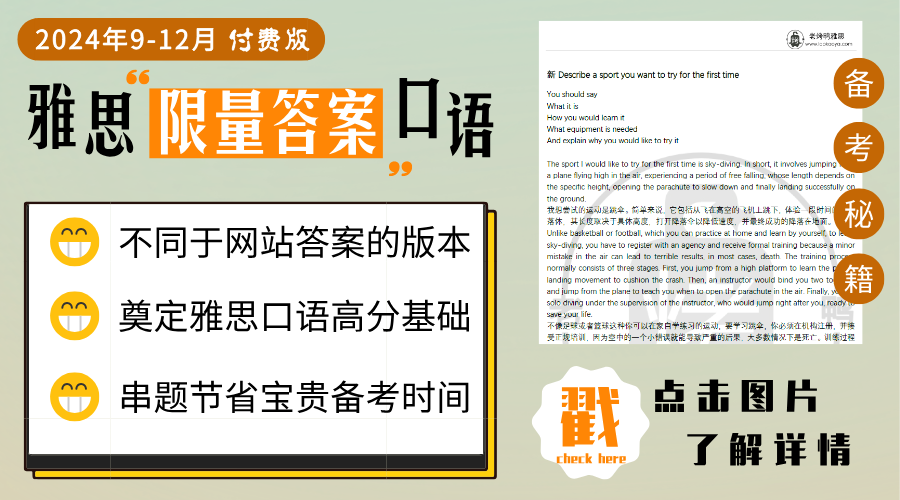剑桥雅思11Test2Passage1阅读原文翻译 Raising the Mary Rose 玛丽玫瑰号
剑桥雅思11阅读第二套题目第一篇文章的主题为玛丽玫瑰号的发现与打捞。文章分为6段,分别介绍了玛丽玫瑰号沉没,发现,打捞的过程。下面是具体每一段的翻译。
点击查看这篇雅思阅读中需要大家掌握的重点词汇以及对应的答案解析:
雅思真题阅读词汇 剑桥雅思11 test 2 passage 1 打捞玛丽玫瑰号rising the Mary Rose
剑桥雅思11Test2Passage1阅读答案解析 Raising the Mary Rose 玛丽玫瑰号
剑桥雅思11 Test2 Passage1阅读原文翻译
第1段
On 19 July 1545, English and French fleets were engaged in a sea battle off the coast of southern England in the area of water called the Solent, between Portsmouth and the Isle of Wight. Among the English vessels was a warship by the name of Mary Rose. Built in Portsmouth some 35 years earlier, she had had a long and successful fighting career, and was a favourite of King Henry VIII. Accounts of what happened to the ship vary: while witnesses agree that she was not hit by the French, some maintain that she was outdated, overladen and sailing too low in the water, others that she was mishandled by undisciplined crew. What is undisputed, however, is that the Mary Rose sank into the Solent that day, taking at least 500 men with her. After the battle, attempts were made to recover the ship, but these failed.
1545年7月19日,英国和法国舰队在英格兰南部海域发生了一起海战。该海域被称为索伦特,位于朴茨茅次和怀特岛之间。英国舰队中有一艘名为玛丽玫瑰号的战舰。她于35年前在朴茨茅次建造,拥有长久而成功的战斗历史,是国王亨利八世的挚爱。关于这艘战舰发生的事情描述各异:虽然目击者都认为她没有被法国舰队击中,但一些人坚持认为她已经过时,装载了太多的东西,吃水太深;而其他人则认为是纪律不良的船员进行了错误操作。然而,毫无争议的是,玛丽玫瑰号在那天沉入了索伦特水域。一同沉没的还有至少500名船员。战斗之后,人们尝试寻找这艘战舰,但都失败了。
第2段
The Mary Rose came to rest on the seabed, lying on her starboard (right) side at an angle of approximately 60 degrees. The hull (the body of the ship) acted as a trap for the sand and mud carried by Solent currents. As a result, the starboard side filled rapidly, leaving the exposed port (left) side to be eroded by marine organisms and mechanical degradation. Because of the way the ship sank, nearly all of the starboard half survived intact. During the seventeenth and eighteenth centuries, the entire site became covered with a layer of hard grey clay, which minimised further erosion.
玛丽玫瑰号靠在海床上,右舷着地成60度角。船体吞噬索伦特洋流所带来沙子和泥土。因此,右舷一侧迅速被填满,使得文章来自老烤鸭雅思左侧暴露在外面,很快被海洋生物和机械降解侵蚀。由于船只的沉没方式,右舷一侧几乎被完整地保留了下来。17世纪和18世纪,整个沉船区域被一层坚硬的灰色粘土覆盖,最大程度减少了进一步的侵蚀。
第3段
Then, on 16 June 1836, some fishermen in the Solent found that their equipment was caught on an underwater obstruction, which turned out to be the Mary Rose. Diver John Deane happened to be exploring another sunken ship nearby, and the fishermen approached him, asking him to free their gear. Deane dived down, and found the equipment caught on a timber protruding slightly from the seabed. Exploring further, he uncovered several other timbers and a bronze gun. Deane continued diving on the site intermittently until 1840, recovering several more guns, two bows, various timbers, part of a pump and various other small finds.
随后,1836年6月16日,索伦特海域的一些渔民发现他们的设备被某种水下障碍物卡住。而该障碍物正是玛丽玫瑰号。潜水员John Deane恰好在附近探索另外一艘沉船。渔民找到他,请他帮助解开他们的设备。Deane潜入水中,发现设备被挂在微微伸出海床的木杆上。进一步探查之后,他发现了一些其他木料,以及一把铜火枪。Deane断断续续地潜入该地点直到1840年。他发现了更多的火枪、两把弓、各种木材、水泵部件,以及其他各种各样的小东西。
第4段
The Mary Rose then faded into obscurity for another hundred years. But in 1965, military historian and amateur diver Alexander McKee, in conjunction with the British Sub-Aqua Club, initiated a project called ‘Solent Ships’. While on paper this was a plan to examine a number of known wrecks in the Solent, what McKee really hoped for was to find the Mary Rose. Ordinary search techniques proved unsatisfactory, so McKee entered into collaboration with Harold E. Edgerton, professor of electrical engineering at the Massachusetts Institute of Technology. In 1967, Edgerton’s side-scan sonar systems revealed a large, unusually shaped object, which McKee believed was the Mary Rose.
玛丽玫瑰号随后又销声匿迹了100多年。1965年,军事历史学家、业余潜水员Axexander Mckee与英国潜水俱乐部合作,发起了一项被称为“索伦特沉船”的项目。纸面上,该计划是要研究一些索伦特海域已知的沉船,但Mckee真正希望的是找到玛丽玫瑰号。常规的搜索技术被证明差强人意,所以Mckee开始与麻省理工学院的电子工程学教授Harold E. Edgerton合作。1967年,Edgerton的侧向扫描声纳系统发现了一个巨大的、形状与众不同的物体。Mckee相信这正是玛丽玫瑰号。
第5段
Further excavations revealed stray pieces of timber and an iron gun. But the climax to the operation came when, on 5 May 1971, part of the ship’s frame was uncovered. McKee and his team now knew for certain that they had found the wreck, but were as yet unaware that it also housed a treasure trove of beautifully preserved artefacts. Interest in the project grew, and in 1979, The Mary Rose Trust was formed, with Prince Charles as its President and Dr Margaret Rule its Archaeological Director. The decision whether or not to salvage the wreck was not an easy one, although an excavation in 1978 had shown that it might be possible to raise the hull. While the original aim was to raise the hull if at all feasible, the operation was not given the go-ahead until January 1982, when all the necessary information was available.
进一步的发掘找到了一些散落的木头片和一支铁制火枪。但整个行动的高潮发生在1971年5月5日。当时找到了部分船只框架。Mckee和他的团队现在明确知道他们发现了沉船,但还没有意识到里面储藏着保存完好的精美艺术品宝藏。人们对该项目的兴趣日益高涨。1979年玛丽玫瑰号信托基金成立,查尔斯王子担任主席,Margaret Rule担任考古负责人。尽管1978年的发掘显示有可能打捞起整个船体,但是否打捞船只的决定却并不容易做出。虽然最初的目的是只要有可能就将船体打捞上来,但该行动直到1982年1月所有信息完备之后才得到批准。
第6段
An important factor in trying to salvage the Mary Rose was that the remaining hull was an open shell. This led to an important decision being taken: namely to carry out the lifting operation in three very distinct stages. The hull was attached to a lifting frame via a network of bolts and lifting wires. The problem of the hull being sucked back downwards into the mud was overcome by using 12 hydraulic jacks. These raised it a few centimetres over a period of several days, as the lifting frame rose slowly up its four legs. It was only when the hull was hanging freely from the lifting frame, clear of the seabed and the suction effect of the surrounding mud, that the salvage operation progressed to the second stage. In this stage, the lifting frame was fixed to a hook attached to a crane, and the hull was lifted completely clear of the seabed and transferred underwater into the lifting cradle. This required precise positioning to locate the legs into the ‘stabbing guides’ of the lifting cradle. The lifting cradle was designed to fit the hull using archaeological survey drawings, and was fitted with air bags to provide additional cushioning for the hull‘s delicate timber framework. The third and final stage was to lift the entire structure into the air, by which time the hull was also supported from below. Finally, on 11 October 1982, millions of people around the world held their breath as the timber skeleton of the Mary Rose was lifted clear of the water, ready to be returned home to Portsmouth.
影响尝试打捞玛丽玫瑰号的一个重要因素在于残存的船体是一个开放的外壳。这导致做出一项重要的决定,即整个提升操作分为三个截然不同的阶段。船体通过螺栓和起吊绳索组成的网固定到起重框架上。利用12个液压起重机解决了船体向下被吸回到泥土中的问题。随着起吊框架缓慢抬升自己的四个支架,船体在几天的时间里被升起几厘米。只有当船体完全悬挂在起吊框架上,离开海床,不受周围泥土吸力的影响时,打捞行动才进行到第二阶段。在该阶段,起重框架被固定在起重机的吊钩上。船体完全脱离海床,在水下被转移到升降篮中。通过考古调查绘画,升降篮被设计的贴合船体,并用空气包填充,从而为船只脆弱的木制框架提供额外的缓冲。第三也是最后一个阶段是将整个船体升至空中。同时船体从下方得到支撑。最终,1982年10月11日,全球数百万人屏息见证了玛丽玫瑰号的木制骨架脱离水面,准备回到朴茨茅次。
What destroyed the civilisation of Easter Island 剑桥雅思11Test2Passage2阅读原文翻译
Neuroaesthetics 神经美学 剑桥雅思11Test2Passage3阅读原文翻译


